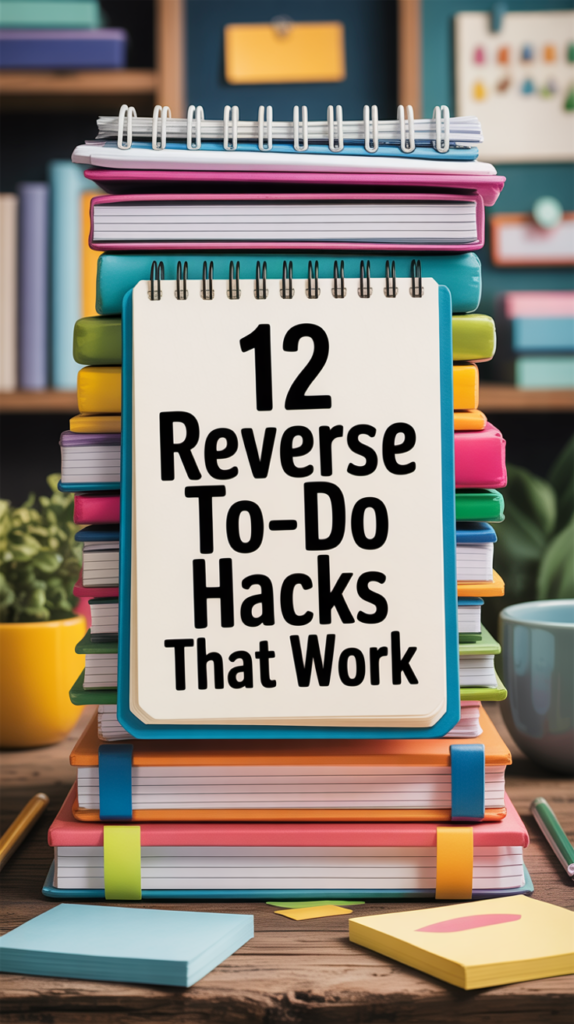Reverse To-Do List: The Trick That Helped Me Feel Like I Was Actually Getting Things Done

Here’s everything you should know about creating a Reverse To-Do List and why it can feel more helpful than the usual way of listing unfinished tasks.
I came across this idea, and it has completely changed how I look at my daily life. I’m excited to tell you about it.
If you’re already organized or trying to get there, you probably know all about to-do lists. You jot down what you need to do in the morning and check things off as you complete them.
It’s a common method that helps cut down on putting things off and keeps you motivated to get more done.
But as much as I like writing these lists to track what’s left to finish, they can also bring a lot of stress and pressure.
Some days, I just want to let things unfold naturally and focus on what feels right in the moment instead of sticking to a plan I wrote hours earlier.
Still, ignoring your tasks altogether doesn’t feel right either.
That’s why the Reverse To-Do List has been such a relief. It’s a different spin on the classic list, where you focus on what you’ve already finished instead of what you still have to do.
What is a Reverse To-Do List?
A Reverse To-Do List turns the usual way of managing tasks on its head.
Instead of starting your day with a long list of chores, you end it by noting everything you accomplished.
This list includes every task you finished, whether it was big or small.
Some people call it the “done list” or the “achievement list.” It’s a simple way to feel thankful and proud of yourself.
I know some folks who love traditional productivity might not find this method very appealing, and that’s okay.
It works best for those of you who struggle to cross things off your list and feel worn out by disappointment.
Or for people like me, who can get through their list but feel drained by always chasing the next goal. Living only for the future can be tiring.
The Reverse To-Do List has changed how I look at my daily routine.
Saying I feel calmer and lighter doesn’t even cover it.
Let me share more about that.
Why I Enjoy Making Reverse To-Do Lists
Writing my Reverse To-Do List has become a comforting part of my evenings. It’s something I truly look forward to.
Here’s a look at how I do it and how it’s made my everyday life feel better.
1. Start With What You Actually Did, Not What You Hope to Do
A regular to-do list is based on hopes. You hope you’ll work out, call your mom, clear your inbox, meal prep, fix the leaky sink, and write your novel — all before dinner.
A Reverse To-Do List is based on facts.
It shows what you actually did. It doesn’t lie. It doesn’t judge. It just helps you see reality clearly.
That small shift made me feel less behind and more aware of how I was using my time.
2. It’s the Fastest Way to Build Momentum
Some days I feel like I’ve done nothing, but then I start writing my Reverse To-Do List:
- Got out of bed, even though I wanted to stay under the covers
- Made coffee
- Answered three work emails
- Took the dog out
- Washed a pan that’s been in the sink for two days
And suddenly, it doesn’t feel like a wasted day anymore.
I did things. I just hadn’t given myself credit for them.
That feeling of momentum — even from small wins — makes it easier to keep going.
3. You Stop Measuring Yourself Against a Fantasy Version of Your Day
Let’s be real.
We all picture this “perfect day” version of ourselves. We wake up early, eat healthy, work hard, stay focused, return texts, exercise, and somehow have energy left to clean the bathroom and FaceTime a friend.
But that version isn’t real.
The Reverse To-Do List forces me to stop comparing myself to that fantasy.
It lets me see the real version of my day — sometimes messy, sometimes productive, often both. And weirdly, I started liking that version of myself more.
4. It Helps You Notice the Invisible Work
So much of what I do in a day doesn’t go on a normal to-do list.
Like changing the bedsheets.
Or sitting through a long, draining meeting.
Or having a hard conversation with someone I care about.
Or just dealing with a noisy, chaotic house when all I want is quiet.
These things take real energy.
They matter.
But we usually don’t write them down. So they don’t “count” in our brains.
Reverse To-Do Lists fix that. They make the invisible visible.
5. It Gives You a Record of Progress, Especially on Hard Days
Sometimes I look back on past lists and I’m surprised by what I see.
Days I thought were useless actually had all kinds of effort tucked inside them.
Maybe I didn’t hit my big goals, but I was still moving — even if it was slow, even if it wasn’t perfect.
That kind of record reminds me: I don’t have to be constantly crushing it to be doing okay.
Surviving, trying, holding things together — that’s work too.
6. It Makes You Kinder to Yourself
I used to beat myself up constantly.
“Why didn’t you finish that? Why did you waste so much time? You’re falling behind.”
But a Reverse To-Do List flips that script.
It shows me where I showed up instead of where I fell short.
It’s like offering yourself a high-five instead of a punch to the gut.
That change in attitude actually makes me more motivated, not less.
7. It’s the Easiest Habit I’ve Ever Stuck With
I’ve tried bullet journals, apps, planners, timers — all of it.
Most of it never stuck.
This one did.
At the end of the day, I just grab a notepad or open a blank doc and list what I remember doing. Doesn’t have to be in order. Doesn’t have to be fancy.
Some days I write five things. Some days I write 30.
Both are fine.
Because it’s not about perfection. It’s about seeing myself clearly.
8. You Can Still Use a Regular To-Do List — But It Won’t Control You
I still use a normal to-do list when I need to stay on track.
But I don’t let it be the boss of me anymore.
Now it’s just a tool, not a scoreboard.
If I only check off two things, I’m not automatically failing.
I’ll still look at my Reverse To-Do List and see everything else I managed to handle — the unexpected stuff, the life stuff, the stuff I didn’t plan but still did.
9. It Works for Every Type of Day
Busy day with work and errands? Reverse To-Do List.
Slow, tired day when I barely leave the couch? Reverse To-Do List.
Emotional, overwhelming day with zero productivity? Yep. Reverse To-Do List.
Because even if I didn’t get anything done in the usual sense, I still existed. I still tried. I still carried something.
And that counts.
10. It Reminds You That You’re Not Lazy — You’re Human
If you’ve ever said “I didn’t do anything today,” I challenge you to try this.
Sit down and write your Reverse To-Do List.
You’ll be surprised at what shows up.
We underestimate how much effort regular life takes. Managing feelings, managing people, managing ourselves — it’s not nothing.
This list helps me stop calling myself lazy just because I didn’t finish a checklist.
It reminds me I’m human, not a machine.
Want to Try It? Here’s How I Do It
- At the end of the day, grab a notebook, app, sticky note — whatever works.
- Write down what you did today. Big stuff, small stuff, all of it.
- Don’t overthink it. Don’t worry about grammar.
- If you forget things, that’s fine. If you remember something from earlier, add it in.
- Be honest. No need to dress it up.
- If you want to, reflect on it. See if any patterns pop up.
That’s it.
You’ve made your first Reverse To-Do List.
It might feel silly at first.
But it worked for me — in ways I didn’t expect.
It made me feel seen.
It helped me notice effort instead of only outcomes.
It reminded me that I do more than I think, even on days when my brain tells me otherwise.
So if you’re tired of feeling like you’re always falling behind, try flipping the script.
Instead of planning what you should do, start noticing what you already did.
You might feel better. You might even feel proud.









